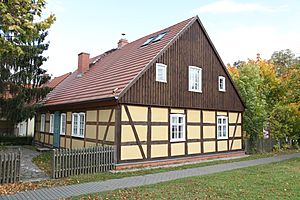Cotter (farmer) facts for kids
A Cotter (also spelled cottier or cottar) was a type of farmer or worker in the past. The word comes from Scots or German. Cotters lived in small houses called cottages. They also farmed small pieces of land.
In old records like the Domesday Book, they were called cotarius. Their exact social status is still discussed by historians. There were not many cotters, less than 7,000 in England. They were mostly found in the southern parts of the country. Cotters either farmed their own small plots or worked on larger farms for other people. They were considered free, but they still had duties to their landlord.
Sometimes, a cottar was also someone who rented land from a farmer or a landlord.
Cotters in Scotland
In Scotland, especially in the Lowlands, cotters made up a large part of the rural population in the 1600s and 1700s. They rented small amounts of land from bigger farmers. Instead of paying rent with money, they often worked for the farmers. This was especially true during busy times like ploughing and harvest.
Many cotters also had other jobs, like weaving cloth or being a blacksmith. In the 1700s, farming methods changed a lot. Farms became much larger and needed fewer workers. This meant there was no longer a place for many cotters. From the 1770s onwards, many cotters moved to growing industrial towns. Others became farm workers or day laborers on the new big farms.
In the Scottish Highlands and islands like Mull, cotters were also affected by the Industrial Revolution. Landowners found they could earn more money from raising sheep for wool than from growing crops. They raised rents so high that cotters could not afford them. Sometimes, entire villages were forced to leave their homes. This was known as the Highland Clearances. Many cotters had to leave their land and move to industrial cities like Glasgow.
Cotters were often shown in a positive way in Scottish poems from the 1700s. Famous examples include "The Cotter's Saturday Night" by Robert Burns.
Cotters in Germany
In Germany, a cotter was called a Kötter or Kossäte. These villagers lived in simple houses called Kate or Kotten (cottages). The term Kötter has been used in Germany since the 1300s. The word Kossäte means "someone who sits in a cottage."
Cotter houses were often separate from the main village. They served as both homes and workshops. Many of these old cotter houses still exist today.
The small farms of cotters were usually on the edge of a village. Often, the land they had was not enough to live on. So, cotters usually had other jobs. They might be craftsmen or work as day laborers on bigger farms. They usually had a small plot of land, but few animals.
Cotters had to pay rent, sometimes with chickens or grain. They also had to work for their landlord. This included helping with the harvest.
Most cotters had a small vegetable garden. This helped them earn a little extra money. Many Kätner (another name for cotters) had a main job besides farming. They might be teachers or craftsmen. They also usually had a small share of the common land used by the village.
In the social order of farmers, a Kötter was below a full-time farmer. However, they were above people who only owned a house and garden and worked as tradesmen. They were also above day laborers.
Over time, cotters were divided into different groups. Some inherited their homes and land within the village. Others were given land far from the village. They had to build a cottage there. These groups still ranked higher than Heuerling, who were more dependent on their landlords.
Cotters in Ireland
In Ireland, from about 1700 to 1850, a cottier was someone who rented a simple cabin. They also rented a small piece of land, usually one to one and a half acres. On this land, they grew potatoes, oats, and sometimes flax. They rented the land year by year. Often, they paid their rent by working for the landlord. The land given to cotters was usually land that landlords thought was not good for other uses.
Cotters often lived at a very basic level. This was because rents were high and there was a lot of competition for land and work. If a cottier improved their land, the rent usually went up. This meant there was no reason for them to make improvements.
In the early 1800s, life for cotters became much harder as the population grew. This way of life ended suddenly with the potato blight. This disease caused the Great Famine from 1845 to 1849. Many peasants died from hunger and disease. After the Famine, the cottier class almost completely disappeared.
See also
- Serfdom - A system where people were tied to the land.
- Enclosure - When common land was fenced off for private use.
Images for kids
-
A cotter house (Kotten) near Solingen, Germany, used as a vacation home today



